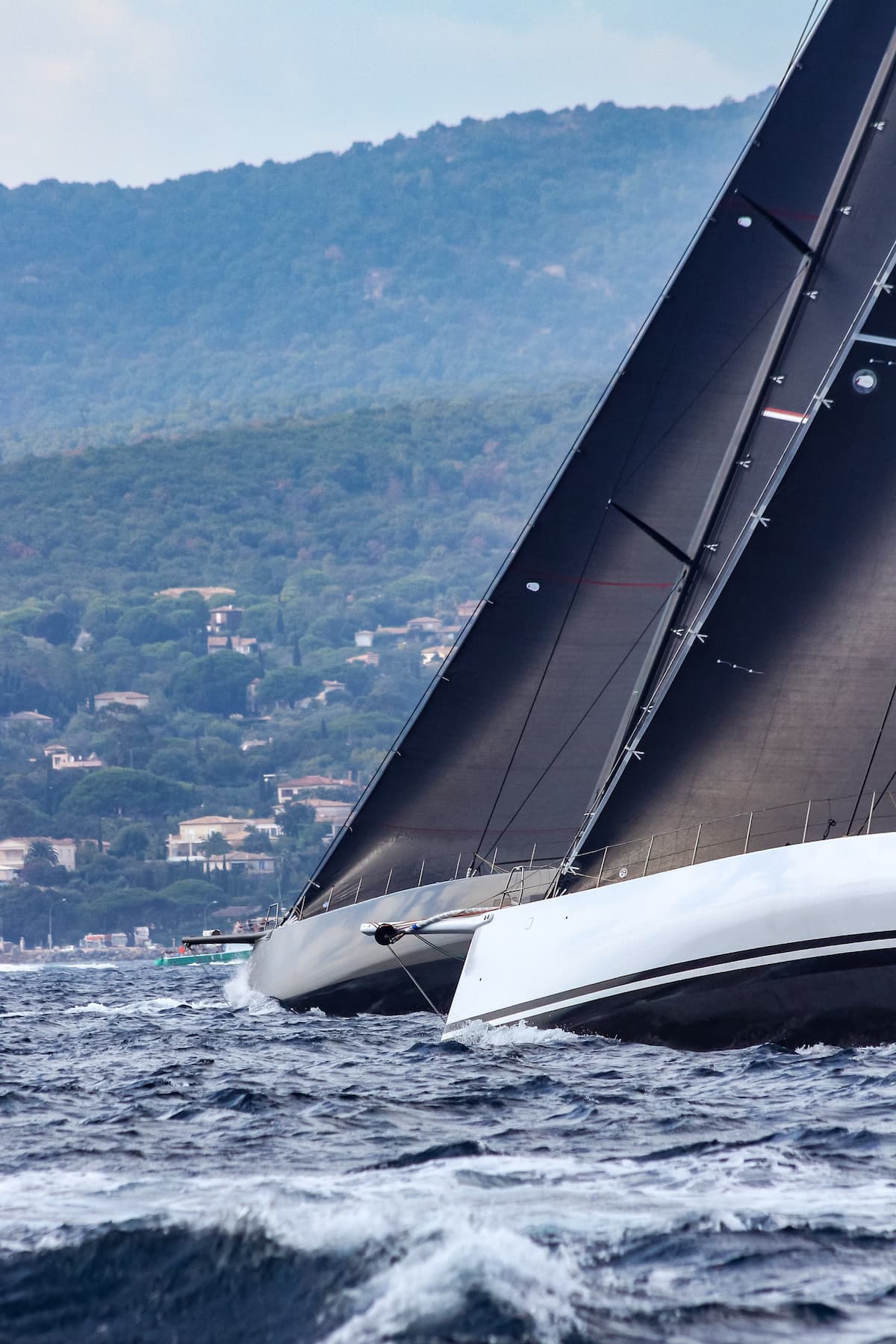Racing sailing yachts are often seen with black sails, which can be a striking and intimidating sight for onlookers. But why do these boats use black sails, and what advantages do they offer?
One reason for the use of black sails is to reduce glare and improve visibility for the crew. White sails can reflect sunlight and create a glare that makes it difficult to see the course ahead, especially in bright conditions. Black sails absorb light and reduce glare, making it easier for sailors to spot obstacles and make quick decisions.
Another advantage of black sails is their ability to absorb heat and transfer it to the sailcloth, which can help to create more lift and speed. This is particularly useful in light wind conditions, where the extra boost can make a significant difference. Additionally, black sails can be made from materials that are more durable and resistant to UV damage, which can extend their lifespan and reduce maintenance costs.

Advantages of Black Sails
Black sails have become a popular choice for racing sailing yachts due to the following advantages:
Sleek Look
Black sails give a sleek and modern look to the yacht, which is visually appealing and can attract sponsors and fans. The sails also look good in photographs and videos, which is important for marketing purposes.
Higher Speeds
Black sails absorb more sunlight than white sails, which makes them warmer and increases their efficiency. This can result in higher speeds, especially in light winds. The difference in speed may not be significant, but it can make a difference in a race where every second counts.
UV Protection
Black sails are less likely to fade or get damaged by UV rays than white sails. This is because black sails absorb more light and heat than white sails, which can cause them to break down faster. Black sails made of carbon fibers are especially resistant to UV damage and can last longer than other materials.
Durability and Strength
Black sails are made of strong and durable materials, such as carbon fibers, which can withstand high winds and rough seas. They are also less likely to get dirty or stained than white sails, which can be a problem in long races.
Weight
Black sails are usually lighter than white sails, which can make a difference in racing. The weight savings can be used to add other equipment or to improve the yacht’s performance.
Heat
Black sails absorb more heat than white sails, which can be a disadvantage in hot weather. The heat can make the yacht’s cabin uncomfortable and can affect the crew’s performance. However, this can be mitigated by using lighter materials or by adding ventilation.
In conclusion, black sails have several advantages over white sails, including a sleek look, higher speeds, UV protection, durability and strength, and weight savings. However, they may not be suitable for all conditions, especially in hot weather.

Disadvantages of Black Sails
Black sails may look sleek and stylish, but they do come with some disadvantages that sailors should consider before choosing them for their racing yachts.
Cost
One of the main disadvantages of black sails is their cost. They are often more expensive than traditional white sails, as they require special materials and manufacturing processes. This can be a significant investment for sailors, and may not be worth it for those on a tight budget.
Maintenance
Black sails also require more maintenance than white sails. They tend to show dirt and stains more easily, which means they need to be cleaned more frequently. Additionally, black sails can be prone to fading over time, which means they may need to be replaced more frequently than white sails.
Delamination
Another potential issue with black sails is delamination. This occurs when the layers of the sail start to separate, which can weaken the sail and make it less effective. Black sails are more prone to delamination than white sails, which means sailors need to be vigilant about checking for signs of damage.
UV Rays
Black sails are also more susceptible to damage from UV rays. The dark color absorbs more sunlight, which can cause the material to break down more quickly. Sailors need to be careful to store their black sails properly and to protect them from the sun when not in use.
Visibility
Finally, black sails can be less visible than white sails, especially in low light conditions. This can make it more difficult for other boats and ships to see the racing yacht, which could be dangerous. Sailors need to take extra precautions to ensure their boat is visible to other vessels on the water.
Overall, while black sails may look impressive, they do come with some drawbacks that sailors need to consider before choosing them for their racing yachts.
Material Composition of Black Sails
Black sails are a common sight in racing sailing yachts. They are often made of a combination of materials that provide the necessary strength and durability for the high-performance demands of racing. Here are some of the materials that are commonly used in the composition of black sails:
- Carbon fibers: Carbon fibers are known for their strength and lightness. They are often used in the construction of high-performance sails, including black sails.
- Polyester: Polyester is a common material used in sail construction. It is known for its durability and resistance to UV rays.
- Kevlar: Kevlar is a type of aramid fiber that is known for its strength and resistance to abrasion. It is often used in the construction of racing sails, including black sails.
- Dyneema fibers: Dyneema fibers are also known for their strength and lightness. They are often used in the construction of high-performance sails.
- Taffeta: Taffeta is a type of non-woven surface material that is often used in sail construction. It provides a smooth surface that reduces drag and improves performance.
In addition to these materials, black sails often have an adhesive layer that helps to bond the various layers of material together. This adhesive layer is essential for providing the necessary strength and durability for racing sails.
Overall, the material composition of black sails is carefully chosen to provide the necessary strength, durability, and performance for racing sailing yachts.
Types of Black Sails
There are several types of black sails used in racing sailing yachts. Each type is designed to provide specific benefits to the yacht and its crew. In this section, we will discuss some of the most popular types of black sails.
3Di Sails
3Di sails are a type of black sail that is known for its durability, lightweight, and high-performance racing capabilities. These sails are made using helix load shearing technology, which allows them to withstand heavy loads and maintain their shape even in strong winds.
There are two main types of 3Di sails: 3Di Ocean and 3Di Endurance. 3Di Ocean sails are designed for offshore racing and cruising, while 3Di Endurance sails are designed for long-distance racing. Both types of sails are made using the same technology and materials, but they are optimized for different sailing conditions.
One of the key benefits of 3Di sails is their ability to maintain their shape over time. Unlike traditional sails, which can stretch and deform over time, 3Di sails are designed to maintain their shape even after extended use. This means that they provide consistent performance throughout their lifespan.
In addition to their performance benefits, 3Di sails are also environmentally friendly. They are made using recyclable materials and are designed to last longer than traditional sails, which reduces the environmental impact of sail production.
Overall, 3Di sails are a popular choice for racing sailing yachts due to their durability, lightweight, and high-performance capabilities. Whether racing offshore or long-distance, these sails are designed to provide consistent performance and withstand the rigors of racing.
Other Sail Colors
While black sails are commonly used in racing sailing yachts, other sail colors can also be used depending on the purpose and preference of the sailor. Here are some of the other sail colors that are used in sailing:
White Sails
White sails are the most common type of sails used in sailing. They are versatile and can be used in different weather conditions. They are also easy to maintain and repair. White sails are often used in cruising and recreational sailing.
Red Sails
Red sails are not commonly used in sailing, but they can be used for racing or for aesthetic purposes. They are not as versatile as white sails and are best used in specific weather conditions.
Tanbark Sails
Tanbark sails are made from a type of dyed canvas that gives them a reddish-brown color. They are often used in traditional and classic sailing yachts for aesthetic purposes. Tanbark sails are not as durable as modern sails and require more maintenance.
Grey Sails
Grey sails are not commonly used in sailing, but they can be used for racing or for aesthetic purposes. They are not as versatile as white sails and are best used in specific weather conditions.
Sail colors can also be influenced by fashion and image. Pirate ships, for example, are often depicted with black sails to create a menacing image. In modern sailing, the choice of sail color can also be influenced by fashion and personal preference.
In conclusion, while black sails are commonly used in racing sailing yachts, there are other sail colors that can be used depending on the purpose and preference of the sailor. White sails are the most common type of sails used in sailing, while red sails, tanbark sails, and grey sails are used for specific purposes. The choice of sail color can also be influenced by fashion and image.
Yacht Racing and Black Sails
Yacht racing is a highly competitive sport that requires the best performance from the boats and the sailors. Many factors can affect the performance of a yacht, including the design, materials, and modifications. One of the most visible modifications that yacht racers use is black sails.
Black sails are not a new concept in yacht racing. They have been used for many years by some of the most successful yacht racers in the world. The reason for this is simple: black sails offer better performance than traditional white sails.
Black sails are made from a different material than white sails. They are made from a high-tech material that is lighter, stronger, and more durable than traditional sailcloth. This material is also more resistant to UV rays, which can cause white sails to degrade over time.
In addition to the material, black sails are also designed differently than white sails. They are cut differently, with a flatter shape that allows them to generate more lift. This increased lift translates into better performance, especially in light wind conditions.
Yacht racers also use black sails because they are more visible on the water. This is especially important in crowded racing conditions, where it can be difficult to see other boats. Black sails stand out against the water and make it easier for sailors to avoid collisions.
Finally, black sails are also easier to maintain than white sails. They do not show dirt or stains as easily, and they do not need to be washed as often. This makes them a popular choice for yacht racers who want to spend more time on the water and less time maintaining their sails.
In conclusion, black sails are a popular choice for yacht racers who want to improve their performance on the water. They offer better lift, increased visibility, and easier maintenance than traditional white sails. While they may not be the right choice for every sailor, they are certainly worth considering for those who want to compete at the highest level of yacht racing.
Conclusion
In conclusion, the use of black sails in racing sailing yachts is not just a fashion statement but has a practical purpose. The black color absorbs more heat than any other color, which helps to warm up the air inside the sail, making it more efficient. The use of black sails is most effective in colder climates where the air is denser and less efficient at powering the sail.
Additionally, black sails are more durable and resistant to UV rays, which can cause damage to the sail over time. This makes black sails a practical choice for racing yachts that are exposed to the sun and wind for extended periods.
However, it is important to note that the use of black sails is not always the best choice. In warmer climates, the heat absorbed by the black sail can cause the air inside to expand, reducing the sail’s efficiency. In these conditions, lighter-colored sails may be more effective.
Overall, the use of black sails in racing sailing yachts is a strategic decision based on the specific conditions of the race and the preferences of the sailors. It is just one of many factors that contribute to the overall performance of the boat and should be carefully considered before making a decision.
- Comprehensive Guide to Hold Cleaning for Cargo Ships: Ensuring Maritime Safety and Efficiency – October 19, 2024
- Responsibilities of a Fourth Engineer on Cargo Ships – September 10, 2024
- The Role of Cargo Ships in Global Trade – August 22, 2024



